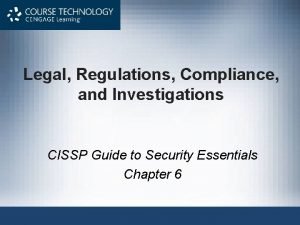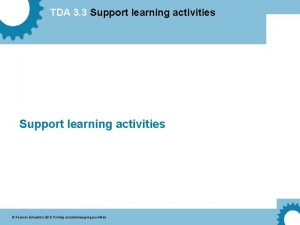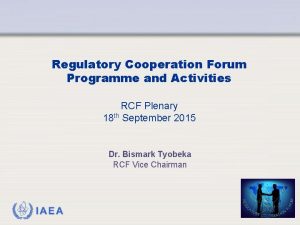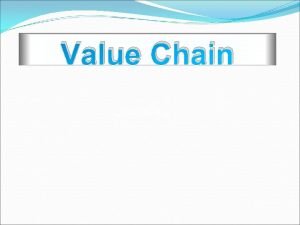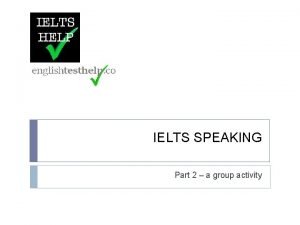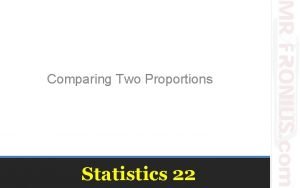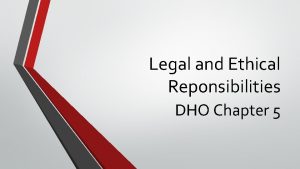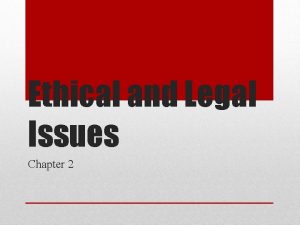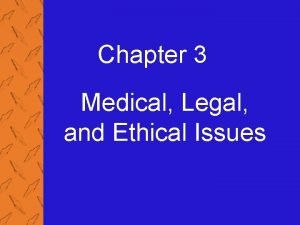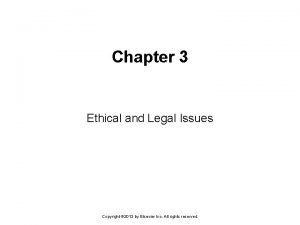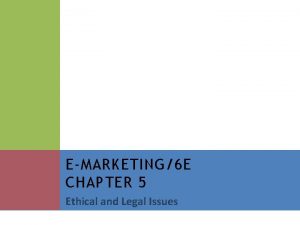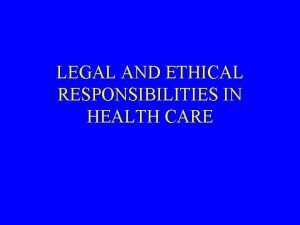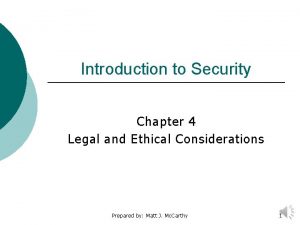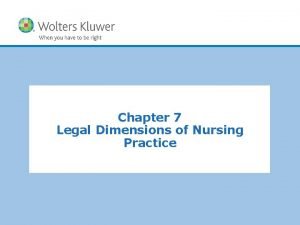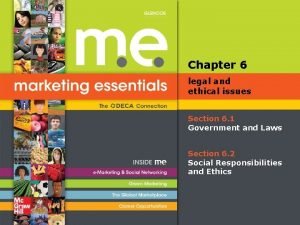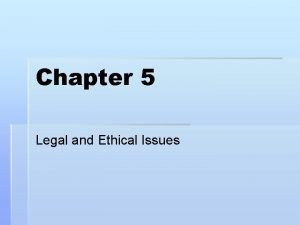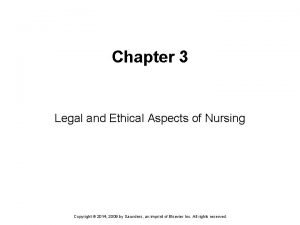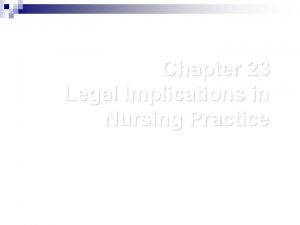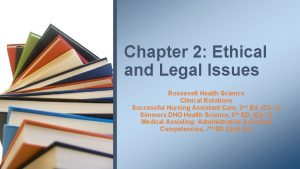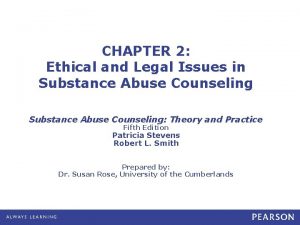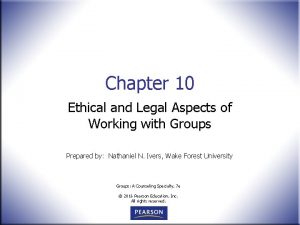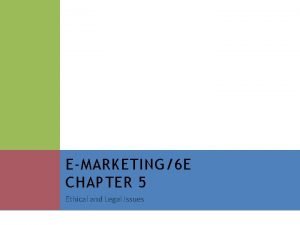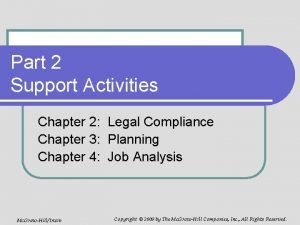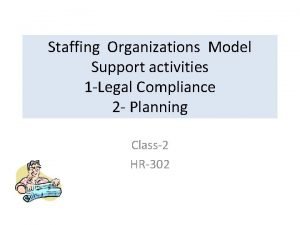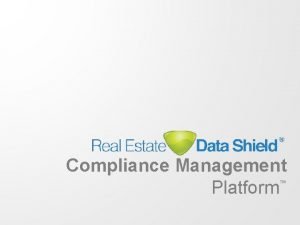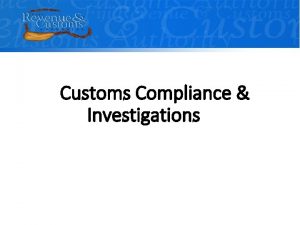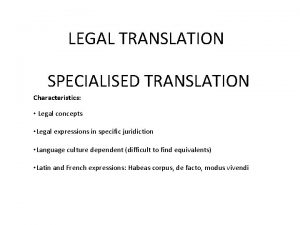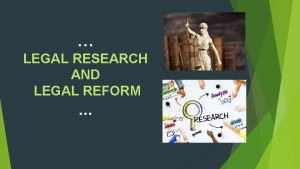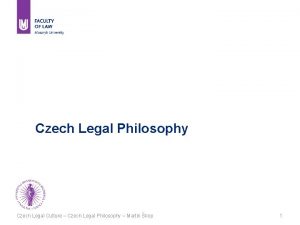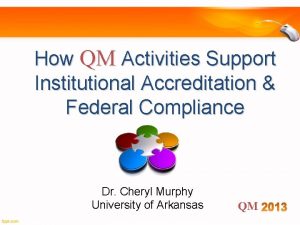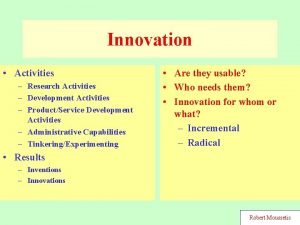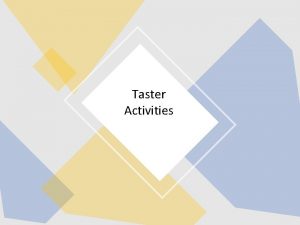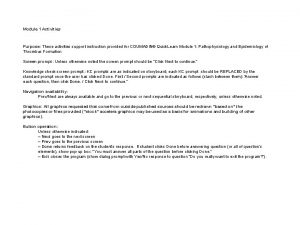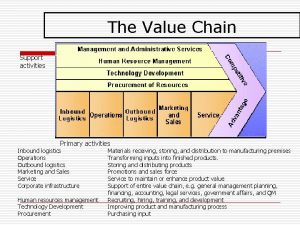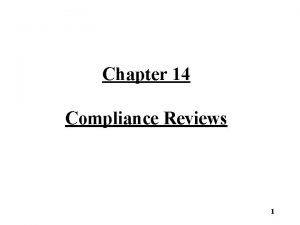Part 2 Support Activities Chapter 2 Legal Compliance



































- Slides: 35

Part 2 Support Activities Chapter 2: Legal Compliance Chapter 3: Planning Chapter 4: Job Analysis Mc. Graw-Hill/Irwin Copyright © 2009 by The Mc. Graw-Hill Companies, Inc. , All Rights Reserved.

Part 2 The Nature of Staffing Chapter 2: Legal Compliance

Staffing Organizations Model Organization Mission Goals and Objectives Organization Strategy HR and Staffing Strategy Staffing Policies and Programs Support Activities Core Staffing Activities Legal compliance Planning Recruitment: Selection: Job analysis Employment: External, internal Measurement, external, internal Decision making, final match Staffing System and Retention Management 2 -3

Chapter Outline The Employment Relationship l Laws and Regulations l EEO/AA Laws: General Provisions and Enforcement l EEO/AA Laws: Specific Staffing Provisions l EEO/AA and Best Practices l Other Staffing Laws l Legal Issues in Remainder of Book l 2 -4

Discussion Questions for This Chapter l l l Do you agree that “the employer usually has the upper hand” when it comes to establishing the employment relationship? When might the employee have maximum power over the employer? What are the limitations of disparate impact statistics as indicators of potential staffing discrimination? Why is each of the four situational factors necessary to establishing a claim of disparate treatment? What factors would lead an organization to enter into a consent agreement rather than continue pursuing a suit in court? What are the differences between staffing in the private and public sectors? Why would private employers probably resist adopting many of the characteristics of public staffing systems? 2 -5

The Employment Relationship l Employer-employee l l Most prevalent form of employment relationship Involves an agreement between employer and employee on terms and conditions of employment l l Independent contractors l l Results in an employment contract Are not considered employees, in a legal sense, of employer Temporary employees l Do not have special legal stature 2 -6

Ex. 2. 1: Matching Process, Employment Contract, and Employment Process 2 -7

Laws and Regulations l Need for laws and regulations l l Balance of power Protection of employees Protection of employers Exh. 2. 2: Sources of Laws and Regulations l l l Common law Constitutional law Statutory law Executive order Agencies 2 -8

Discussion Questions l Do you agree that “the employer usually has the upper hand” when it comes to establishing the employment relationship? When might the employee have maximum power over the employer? 2 -9

Exh. 2. 3: Major Federal/AA Laws: General Provisions 2 -10

Ex. 2. 3: Major Federal/AA Laws 2 -11

Disparate Treatment Involves allegations of intentional discrimination where employer knowingly discriminated on basis of specific characteristics l Evidence l l May be direct May consist of a mixed motive May be inferred from situational factors l l 1. Person belongs to a protected class 2. Person applied for, and was qualified for, a job employer was trying to fill 3. Person was rejected despite being qualified 4. Position remained open and employer continued to seek applicants as qualified as person rejected 2 -12

Disparate / Adverse Impact l Focuses on effect of employment practices, rather than on motive or intent underlying them l l As a result of a protected characteristic, people are adversely affected by an employment practice Evidence -- Involves use of statistics l Exh. 2. 5: Types of Disparate Impact Statistics l Applicant flow statistics l l l Four-fifth’s rule - An employment practice has disparate impact if hiring rate for minority group is less than four-fifths (or 80%) of hiring rate for majority group Stock statistics Concentration statistics 2 -13

Litigation Process - EEOC Disparate treatment Disparate impact Show intent? Yes No Prima facie case Disparate treatment intentional practice Disparate impact - effect of practice Employer’s rebuttal Nondiscriminatory reason(s) for practice or show BFOQ Practice job-related and consistent with business necessity Plaintiff’s rebuttal Reason is a pretext for discrimination Consent decree; compensatory and punitive damages Remedies Practice not job-related; employer does not adopt practice with less disparate impact Consent decree; equitable relief, i. e. back pay 2 -14

Exh. 2. 5: Types of Disparate Impact Statistics 2 -15

Discussion Questions l What are the limitations of disparate impact statistics as indicators of potential staffing discrimination? l Why is each of the four situational factors necessary to establishing a claim of disparate treatment? 2 -16

Enforcement by EEOC: Initial Charge and Conciliation l l l Charge filed Investigation to determine “reasonable cause” If “reasonable cause” found, conciliation is pursued l l Voluntary settlement process Preferred method of settlement If EEOC decides not to pursue a claim, a “right to sue” letter is issued to complaining party l Complementing conciliation is mediation l l Neutral, third-party mediates dispute to obtain agreement to resolve dispute 2 -17

Exh. 2. 7: Basic Litigation Process EEOC 2 -18

Enforcement by OFCCP Enforcement mechanisms differ from those of EEOC l Covered employers required to develop and implement written AA plans l Enforcement involves l l Off-site desk audits/reviews of employers’ records and AA plans On-site visits/compliance reviews of employers’ AA plans Employers found in noncompliance urged to change practices through conciliation l If conciliation is unsuccessful, employers subject to penalties affecting their status as federal contractors 2 -19

Discussion Questions l What factors would lead an organization to enter into a consent agreement rather than continue pursuing a suit in court? 2 -20

EEO / AA Laws: Specific Staffing Provisions l Civil Rights Act of 1964 l l l Unlawful employment practices Establishment of disparate impact Disparate treatment Mixed motives Bona fide occupational qualification (BFOQ) Testing Test score adjustments Seniority or merit systems Employment advertising Pregnancy Preferential treatment and quotas 2 -21

EEO / AA Laws: Specific Staffing Provisions l Age Discrimination in Employment Act (1967) Prohibited age discrimination l BFOQ l Factors other than age l Seniority systems l Employment advertising l 2 -22

EEO / AA Laws: Specific Staffing Provisions l Americans with Disabilities Act (1990) Prohibited discrimination l Definition of disability l l Physical and mental impairments substantially limiting a major life activity 2 -23

EEO / AA Laws: Specific Staffing Provisions l Americans with Disabilities Act (1990) l EEOC clarifications l l Impairment - “A physiological disorder affecting one or more of a number of body systems or a mental or psychological disorder. ” Expanded major life activities include “sitting, standing, lifting, and mental and emotional processes such as thinking, concentrating, and interacting with others. ” Whether an impairment is substantially limiting depends on its nature and severity, duration or expected duration, and its permanency or long-term impact. To be substantially limiting, impairment must prevent/significantly restrict a person from performing a class or broad range of jobs in various classes. 2 -24

EEO / AA Laws: Specific Staffing Provisions l Americans with Disabilities Act (1990) Qualified individual with a disability l Essential job functions l Reasonable accommodation and undue hardship l Selection of employees l Medical exams for job applicants and employees l Affirmative action l 2 -25

EEO / AA Laws: Specific Staffing Provisions l Rehabilitation Act (1973) l Prohibited discrimination l Affirmative action l Executive Order 11246 (1965) l Prohibited discrimination l Affirmative action 2 -26

Other Staffing Laws: Immigration Reform and Control Act (1986) l Purpose l l To prohibit employment of unauthorized aliens To provide civil and criminal penalties for violations Prohibited discrimination l Employment verification system -- I-9 form l l l Employer must verify individual is not an unauthorized alien and is legally eligible for employment Individuals must offer proof of identity Temporary foreign workers l Enforcement l l l Enforced by Department of Justice Noncompliance may result in fines up to $10, 000 2 -27

Other Staffing Laws: Employee Polygraph Protection Act (1988) l Purpose l l Prevent most private employers from using a polygraph on job applicants or employees Prohibited practices l l l Requiring applicants or employees to take a polygraph Using results of a polygraph for employment decisions Discharging or disciplining individuals for refusal to take a polygraph Examples of instances where polygraph may be used l Enforcement l l l Enforced by Department of Labor Noncompliance may result in fines up to $10, 000 2 -28

Other Staffing Laws: Fair Credit Reporting Act (1970) l Purpose l l Regulates organization’s acquisition and use of consumer reports on job applicants Required compliance l Before obtaining a report, organization must l l l If an “adverse action” is taken, organization must l l Give applicant notice in writing a report may be obtained Obtain written authorization from applicant Notify (written, oral, electronic) applicant of adverse action Provide information of consumer reporting agency to applicant Provide notice of applicant’s rights to applicant Enforcement l l Enforced by Federal Trade Commission Noncompliance may result in fines up to $1, 000 2 -29

Other Staffing Laws: State and Local Laws l EEO / AA laws l l Often patterned after federal laws Basic provisions vary from state to state Often provide protections beyond those contained in federal laws and regulations Other state laws l l l Employment-at-will Workplace torts Examples of other covered areas l Criminal record inquiries by employer, polygraph and “honesty” testing, drug testing, AIDS testing, employee access to personnel records 2 -30

Other Staffing Laws: Civil Service Laws and Regulations l Merit principles and staffing practices l Merit principles relevant to staffing l l l To recruit, select, and promote employees on the basis of their KSAOs To provide for fair treatment of applicants and employees without regard to political affiliation, race, color, national origin, sex, religion, age, or handicap To protect privacy and constitutional rights of applicants and employees as citizens To protect employees against coercion for partisan political purposes Principles codified in civil service laws and regulations 2 -31

Other Staffing Laws: Civil Service Laws and Regulations (continued) l Comparisons with private sector l l Notable differences exist between public and private sectors Examples of public sector staffing practices l l l Open announcement of all vacancies, along with content of selection process to be followed Large numbers of applicants due to applications being open Legal mandate to test applicants only for KSAOs directly job-related Limits on discretion in final hiring process, such as number of finalists, ordering of finalists, and AA considerations Rights of applicants to appeal hiring decision, testing process, or actual test content and method 2 -32

Discussion Questions l What are the differences between staffing in the private and public sectors? Why would private employers probably resist adopting many of the characteristics of public staffing systems? 2 -33

Ethical Issues l Issue 1 l Assume that you’re the staffing manager in a company that informally, but strongly, discourages you and managers from hiring people with disabilities. The company’s rationale is that people with disabilities are unlike to be high performers or long term employees, and are costly to train, insure, and integrate into the work unit. What is your ethical assessment of the company’s stance; do you have an ethical obligation to try to change the stance, and if so, how might you go about that? 2 -34

Ethical Issues l Issue l 2 Assume the company you work for practices strict adherence to the law in its relationships with employees and job applicants. The company calls it “staffing by the book. ” But beyond that, it feels that “anything goes” in terms of tolerated staffing practices. What is your assessment of this approach? 2 -35
 Support activities and primary activities
Support activities and primary activities Legal regulations compliance and investigation
Legal regulations compliance and investigation Operating activities vs investing activities
Operating activities vs investing activities Now group these activity into indoor and outdoor activities
Now group these activity into indoor and outdoor activities Primary activities and secondary activities
Primary activities and secondary activities Tda 3.3 support learning activities
Tda 3.3 support learning activities Support activities
Support activities Support activities
Support activities Minor and major supporting details
Minor and major supporting details Ielts speaking topics with answers
Ielts speaking topics with answers Would being part of a support group that meets regularly
Would being part of a support group that meets regularly Part part whole addition
Part part whole addition Part to part ratio definition
Part to part ratio definition Brainpop ratios
Brainpop ratios Define technical description
Define technical description Basic parts of a bar
Basic parts of a bar The phase of the moon you see depends on ______.
The phase of the moon you see depends on ______. Minitab adalah
Minitab adalah Dho chapter 5 legal and ethical responsibilities
Dho chapter 5 legal and ethical responsibilities Ethical and legal issues chapter 2
Ethical and legal issues chapter 2 Medical legal and ethical issues chapter 3
Medical legal and ethical issues chapter 3 Chapter 3 ethical and legal issues
Chapter 3 ethical and legal issues Chapter 5 legal and ethical issues
Chapter 5 legal and ethical issues Legal and ethical issues chapter 5
Legal and ethical issues chapter 5 Emt chapter 3 medical legal and ethical issues
Emt chapter 3 medical legal and ethical issues Legal and ethical responsibilities in health care
Legal and ethical responsibilities in health care Chapter 4 legal and ethical responsibilities
Chapter 4 legal and ethical responsibilities Legal safeguards in nursing practice
Legal safeguards in nursing practice Chapter 6 legal and ethical issues
Chapter 6 legal and ethical issues Legal and ethical issues chapter 5
Legal and ethical issues chapter 5 Chapter 3 legal and ethical issues
Chapter 3 legal and ethical issues Chapter 23 legal implications in nursing practice
Chapter 23 legal implications in nursing practice Chapter 2 ethical and legal issues
Chapter 2 ethical and legal issues Chapter 2 ethical and legal issues
Chapter 2 ethical and legal issues Chapter 5 legal and ethical responsibilities worksheet
Chapter 5 legal and ethical responsibilities worksheet Legal and ethical issues chapter 5
Legal and ethical issues chapter 5

